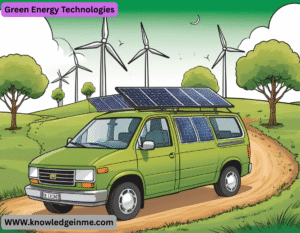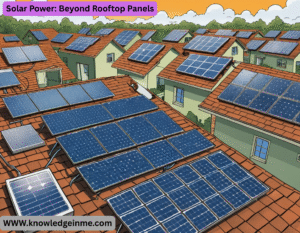Green Energy Technologies refer to systems and methods of generating energy from renewable, sustainable sources that have minimal environmental impact. These technologies aim to reduce reliance on fossil fuels, lower greenhouse gas emissions, and promote energy efficiency. Here are some key green energy technologies:
Solar Power
- Photovoltaic (PV) Cells: Convert sunlight directly into electricity using semiconductor materials (e.g., silicon panels).
- Concentrated Solar Power (CSP): Uses mirrors or lenses to focus sunlight onto a small area, generating heat that drives steam turbines.
- Applications: Rooftop solar panels, solar farms, and portable solar chargers.
Wind Energy
- Onshore & Offshore Wind Turbines: Convert kinetic energy from wind into electricity using large rotor blades and generators.
- Small-Scale Wind Systems: Used for residential or remote power needs.
- Advancements: Floating wind turbines for deeper offshore locations.
Hydropower
- Large-Scale Dams: Generate electricity by releasing water through turbines.
- Small Hydropower & Micro-Hydro: Low-impact systems for local energy needs.
- Pumped Storage Hydropower: Stores energy by pumping water uphill during low demand and releasing it during peak demand.
Biomass & Bioenergy
- Biofuels (Ethanol, Biodiesel): Produced from crops (corn, sugarcane), algae, or waste oils.
- Biogas: Generated from organic waste (landfills, animal manure) via anaerobic digestion.
- Wood & Agricultural Residues: Used for heating or electricity in biomass power plants.
Geothermal Energy
- Geothermal Power Plants: Use heat from Earth’s core to generate steam for turbines.
- Direct Use & Heat Pumps: Provide heating/cooling for buildings via underground thermal energy.
- Enhanced Geothermal Systems (EGS): Artificial reservoirs created in hot dry rock for wider use.
Hydrogen & Fuel Cells
- Green Hydrogen: Produced via electrolysis (using renewable electricity to split water into H₂ and O₂).
- Fuel Cells: Convert hydrogen into electricity with only water as a byproduct (used in transport and industry).
Ocean Energy
- Tidal Power: Uses underwater turbines to harness energy from tidal currents.
- Wave Energy: Converts ocean wave motion into electricity via floating devices.
- Ocean Thermal Energy Conversion (OTEC): Exploits temperature differences between surface and deep water.
Energy Storage & Grid Integration
- Batteries (Lithium-ion, Solid-State, Flow Batteries): Store excess renewable energy.
- Smart Grids: Use AI and IoT to optimize energy distribution and demand response.
- Vehicle-to-Grid (V2G): Electric vehicles supply power back to the grid when needed.
Emerging Innovations
- Perovskite Solar Cells: More efficient and cheaper than traditional silicon PV.
- Nuclear Fusion: Potential for limitless clean energy (still in experimental stages).
Benefits of Green Energy Technologies
- Reduces carbon emissions and air pollution.
- Enhances energy security by diversifying supply.
- Creates jobs in manufacturing, installation, and R&D.
- Lowers long-term energy costs as technology scales up.
Solar Power: Beyond Rooftop Panels
Emerging Tech
- Bifacial Solar Panels – Capture sunlight on both sides, increasing efficiency by 10-20%.
- Solar Skins – Aesthetic panels that blend with rooftops (e.g., Tesla Solar Roof).
- Agrivoltaics – Combining agriculture with solar farms (panels provide shade for crops).
Challenges:
- Recycling old panels (toxic materials like cadmium).
- Land use conflicts in large-scale solar farms.
- Global Leader: China (produces ~75% of the world’s solar panels).
Wind Energy: Bigger and Smarter Turbines
Trends:
- 15+ MW Turbines (e.g., GE’s Haliade-X, with blades longer than football fields).
- Floating Wind Farms – Deployed in deep waters (e.g., Hywind Scotland).
- AI Optimization – Predictive maintenance using machine learning.
Challenges:
- Bird/bat collisions.
- Public opposition to onshore wind (“NIMBY” syndrome).
Hydropower: Small Scale & Eco-Friendly
Innovations:
- Fish-Friendly Turbines – Minimize harm to aquatic life.
- Kinetic Hydropower – Generates power from rivers without dams (e.g., Verdant Power’s tidal turbines).
Controversies:
- Displacement of communities (e.g., Three Gorges Dam in China).
- Methane emissions from rotting vegetation in reservoirs.
- Leader: Norway (99% renewable electricity, mostly hydro).
Biomass: Waste to Energy Revolution
Breakthroughs:
- Algae Biofuels – High yield per acre (ExxonMobil invested $300M+ in research).
- Pyrolysis – Converts plastic waste into fuel.
Debates:
- Carbon neutrality of biofuels (land-use change emissions).
- Competition with food crops (e.g., corn ethanol).
- Case Study: Sweden imports waste to fuel biomass plants.
Geothermal: Tapping Earth’s Heat
New Frontiers:
- Supercritical Geothermal – Drilling deeper for higher temps (Iceland’s IDDP project).
- Geothermal for Hydrogen – Using heat to split water into H₂.
Limitations:
- Only viable near tectonic boundaries (e.g., Iceland, Kenya).
- High drilling costs ($5M–$20M per well).
- Pioneer: Kenya (47% of its grid is geothermal).
Hydrogen: The Clean Fuel of the Future
Types of Hydrogen:
- Grey H₂ (from fossil fuels, emits CO₂).
- Blue H₂ (grey + carbon capture).
- Green H₂ (from renewables, zero emissions).
Applications:
- Steelmaking (replacing coking coal).
- Long-haul trucks (e.g., Nikola Motors).
Hurdles:
- High cost ($4–$6/kg vs. $1/kg for grey H₂).
- Explosive nature; requires safe storage.
Ocean Energy: The Untapped Giant
Current Projects:
- MEYGEN Tidal Array (Scotland) – 398 MW capacity by 2027.
- Wave Roller (Portugal) – Converts waves into grid power.
Obstacles:
- Corrosion from seawater.
- High maintenance costs.
Energy Storage: Beyond Lithium Ion
Next-Gen Batteries:
- Solid-State Batteries (Toyota plans to launch by 2027).
- Iron-Air Batteries (Form Energy’s 100-hour storage).
Alternatives:
- Gravity Storage (Energy Vault’s concrete blocks).
- Thermal Storage (molten salt in CSP plants).
Solar Power: The Next Frontier
- Beyond Silicon: Revolutionary Materials
- Perovskite Solar Cells
- Potential to hit >30% efficiency (vs. ~22% for silicon).
- Tandem Solar Cells (perovskite + silicon) achieve >40% in labs (Oxford PV).
- Challenge: Degrades quickly—researchers use 2D/3D heterostructures to improve stability.
Quantum Dot Solar
- Theoretical efficiency limit: 66% (Shockley-Queisser limit for silicon is 33%).
- Transparent Solar Panels
- MIT’s “Solar Windows” use organic molecules to generate power while allowing light through.
- Space-Based Solar Power (SBSP)
- China’s plan: A 1MW orbital solar farm by 2030, scaling to 1GW by 2050.
- Obstacles: Launch costs ($1,000/kg → need <$100/kg to be viable).
Wind Energy: Pushing Physical Limits
Gigantic Turbines & Aerodynamics
- GE’s 18MW Haliade-X (260m rotor, one turbine powers 16,000 homes/year).
- Vortex Bladeless – No rotating blades; uses oscillating poles for low-maintenance energy.
Offshore Wind Innovations
- Floating Wind Turbines (Equinor’s Hywind Tampen powers North Sea oil rigs).
- Kite Power (Makani’s airborne turbines tap high-altitude winds).
AI & Robotics in Wind Farms
- Autonomous Drones inspect blades using computer vision.
- Digital Twins simulate turbine wear in real-time (Siemens).
Hydropower: Reinventing the Dam
Low-Impact Hydro
- Vortex Turbines – Fish-safe, no dam required (Belgium’s Turbulent).
Pumped Hydro 2.0
- Underground reservoirs (abandoned mines → energy storage).
- Seawater pumped hydro (Okinawa’s 30MW plant).
Salinity Gradient Power
- Blue Energy – Mixing freshwater and seawater (Dutch RED stack pilot).
Biomass: Beyond Combustion
Synthetic Biology & Algae
- CRISPR-edited algae (Sapphire Energy boosts lipid production).
- Bacterial Nanowires – Genetically engineered microbes produce electricity from waste.
Waste-to-Energy Breakthroughs
- Plasma Gasification – Superheats trash into syngas (no ash; Japan’s Hitachi).
- Pyrolysis + Carbon Capture – Turns agricultural waste into biochar (permanent CO₂ removal).
Geothermal: Engineered Earth Batteries
Enhanced Geothermal (EGS)
- Fracking for Clean Energy – Inject water into hot rock (DOE’s FORGE project).
- Supercritical CO₂ as a Working Fluid – More efficient than water (MIT spinout Quaise).
Geothermal for Direct Air Capture DAC
- Clime works + ON Power (Iceland) – Uses geothermal heat to capture CO₂ from air.
Hydrogen: The Hype vs. Reality
Turquoise Hydrogen
- Methane Pyrolysis – Splits natural gas into H₂ + solid carbon (no CO₂ emissions).
Hydrogen Storage & Transport
- Liquid Organic Hydrogen Carriers (LOHCs) – Safe, dense storage (Germany’s Hydrogenious).
- Ammonia (NH₃) as H₂ Carrier – Japan’s SUISO Frontier ship transports H₂ as ammonia.
Nuclear Hydrogen
- High-temp reactors (HTGRs) split water 3x more efficiently than electrolysis (US DOE project).
Ocean Energy: The Sleeping Giant
Tidal Stream Farms
- Orbital Marine’s O2 Turbine (Scotland) – 2MW per unit, 20-year lifespan.
Wave Energy’s Comeback
- Cor Power’s C4 Buoy – Mimics human heart pumping for 5x efficiency.
Ocean Thermal Energy (OTEC)
- Lockheed Martin’s 10MW OTEC plant (Hawaii) – Powers 3,000 homes from seawater温差.
.






